Wondering what size speaker wire you need? You’re in the right place!
In this guide, I’ll show you the proper gauge and type of speaker wire you need. I’ll also cover a lot more, too:
- Simple & quick rules of thumb for speaker wire size if that’s all you need to know.
- Speaker wire gauge and the American Wire Gauge chart explained.
- Understanding copper clad aluminum (CCA) vs pure copper wire so you don’t get ripped off.
- Solid vs stranded wire .
Contents
General tips: What size speaker wire do I need?
- For most low power home or car speakers (not subwoofers) 18 gauge (18AWG) is fine. 18AWG wire is good for about 50 watts for 4 ohms and 100 watts for 8 ohm loudspeakers up to 50 feet (15 m) or 100 feet (30 m) respectively.
- For higher power systems or longer lengths, 16 gauge is a great choice.
- For longer lengths (50-100ft)/(15-30.5m) you’ll need to go up 2 gauges (14 ga.) to avoid losing power. Very long lengths of speaker wire lose a bit of power over the long distance due to resistance. Using larger wire can help reduce or avoid this. (Use my speaker wire calculator to make it easy)
- A higher speaker impedance value (ex.: 6 or 8 ohm speakers) draws less current (lower amps) than lower impedance speakers. Therefore you often can use a thinner wire for them as you’ll see.
Simple “everyday” wire size table
| Wire Size | Recommended For |
|---|---|
| 18 AWG | Car and home speakers up to 25 ft with average power levels (50W RMS and below). |
| 16 AWG | Longer speaker runs for car & home stereo speakers or short runs under 20 ft for 75-100W. Moderate power subwoofers (under 225W) with short lengths. |
| 14 AWG | Long (100ft+) speaker runs or higher power applications such as high-power 2 or 4 ohm subwoofers with a short length. |
In most cases for everyday listening at medium or low power levels (50W RMS or under), 18 gauge (18AWG) wire is what you need.
It’s a good compromise between price and power handling as it’s usually affordable and easy to find.
How to find the correct size wire for ANY length or speaker system
The correct gauge speaker wire you need is based on 3 things:
- Your stereo or amplifier’s power output.
- The speaker’s impedance (Ohms) rating – also called the nominal impedance.
- The cable length needed for your speaker system.
However, I’ve made it easy for you: You can use my speaker wire size calculator or speaker wire size chart sections provided below.
SPEAKER WIRE GAUGE CALCULATOR
My speaker wire gauge calculator will recommend the right speaker wire gauge based on the power, speaker Ohms, and the specific length you need. This is different from the speaker wire size chart section below that provides lengths based on the speaker Ohms only and doesn’t need power ratings.
You can play around with different power amounts, lengths, and speaker Ohms to find the best speaker wire gauge for your audio setup and avoid spending more money than necessary.
HOW TO USE THE CALCULATOR:
- Enter the following:
- The wire length you need. This can be whole or fractions (5 ft, 2.6 ft, etc.).
- RMS/continuous power for your amp or stereo. (Do not use “peak” or “max.” power ratings.)
- The speaker impedance in Ohms (Ω).
- Touch the button to get the results.
The wire calculator will output:
- The smallest wire size with 5% or less power loss for both copper and copper-clad aluminum (CCA) wire.
- The power loss across the wire, in Watts, at maximum power output.
SPEAKER WIRE GAUGE CHART
The chart and tables above are handy if you aren’t sure about your stereo or amplifier power. You can estimate the length of wire you can use without losing a lot of power (at maximum stereo or amplifier output) knowing only the speaker Ohm rating.
Both copper wire and copper clad aluminum (CCA) wire charts are provided. Because aluminum has a lower conductivity than copper (higher resistance per foot), the length will be shorter than for real copper.
Note: Be sure to check my additional tips further below as they can help you save money.
Choosing a speaker wire gauge for long distances
What if you need say 50ft or even 100ft of length? In that case, a general rule of thumb is to double the size by choosing a wire thickness 2 sizes up from what you would use for shorter distances.
The gauge number (the electrical conductor size as per wire standard charts) increases or decreases by an even number (by adding or subtracting 2) as odd numbers aren’t commonly used.
Example: 18AWG wire will lose about 4 watts at maximum power if it’s 50ft long. To avoid this when moving from a shorter wire length, we can pick a speaker cable 2 sizes up: 18 AWG -> 16 AWG -> 14 AWG.
Tips on using smaller speaker wire and saving money
As real copper wire is more expensive these days and because most people don’t drive speakers at full power, here are some tips to keep costs down:
- If you rarely use your amp or stereo output above 50%-60% power, you can go down one wire AWG gauge. This is because you’ll never reach the wire’s current capacity if you don’t use maximum power.
- Have extra wire you’d like to put to good use? You can double-up or even triple-up smaller gauge wire to get the same gauge as a thicker wire size. (Example: using two lengths of 18AWG you have lying around in parallel to approximate 16AWG wire).
- For surround sound and center channel home theater speakers, you shouldn’t spend a lot because their power needs are usually fairly low.
Is oxygen free speaker wire worth it?
No, oxygen free pure copper wire will not deliver any noticeable improvements in sound or power. It’s not worth spending more money on it.
It’s a great marketing feature for retailers but the data shows that there’s an amazingly small difference in performance. Paying more is a waste of money. As long as you’re using a good quality wire with the correct gauge you’ll be fine.
The electrical signal will not have any measurable difference at the speaker end.
It is true, however, that real copper wire is better than copper coated aluminum wire as I explain later.
What gauge is speaker wire? (Wire size and wire gauge explained)
Speaker wire doesn’t have just one size (gauge) – it’s standardized and based on the American Wire Gauge (AWG) chart which lists standard sizes using a number.
Less commonly known as the Brown and Sharpe wire chart, the American Wire Gauge chart has been around since 1857. It specifies sizes, each with a given circular area of the electrical conductor size, its resistance per foot or meter, and some other specifications.
Likewise, each AWG wire gauge has an electrical current capacity (how many amps it can handle, also called ampacity sometimes).
The AWG wire chart uses a numbering system in which thicker cable has a smaller number. Likewise, a larger number is used for smaller wires with fewer conductors.
Speaker impedance and power vs the correct gauge wire
When an amplifier supplies an audio signal with a given voltage output, speakers with a lower impedance draw more electrical current (higher amps) than higher impedance speakers. This can make a difference in the wire size you need based on the length and power carried to audio speakers.
Higher amps require a larger conductor size (thick wire) just like for power wire. By comparison, thicker speaker wire has low resistance and therefore less power lost across it at high power levels or a long cable run.
Most speaker wire sold today is made up of two conductors attached as a pair with one marked as the positive; they’re essentially the same as stranded power cable paired together. The gauges available range from about 20 gauge to 10 gauge, with 18 gauge being one the most popular.
Thin wire such as 20AWG or 22AWG isn’t very common but occasionally can be useful for lower power speakers.
Stranded vs solid conductors
All speaker wire sold is stranded, meaning it’s made up of a bundle of 16-60 or more very fine copper conductors. Solid wire, however, has only one conductor. In terms of audio, it’s fine and the sound quality is the same.
You may have heard of the skin effect in some conductors which becomes more of an issue at higher frequencies but that’s well above the 20 to 20kHz audio range so it’s not something to worry about.
Stranded speaker wire design
For stranded types, a thicker wire gauge uses more conductor strands with each strand being larger than those in a smaller gauge wire. Some types simply use more very fine strands to enhance flexibility during use but will still maintain the same total conductor cross area and current carrying capacity.
Why stranded speaker wire is preferred over solid
Stranded wire has a big advantage over solid in that it’s very flexible and not prone to breaking under stress. It’s also easier to strip the insulation to bare wire with a wire stripper. It’s also easier to work with if using spade connectors or inserting it into a crimp connector.
Since solid core is used for home and industrial electrical wiring, you might be tempted to use some leftover house electrical wire for your speakers. There’s no technical reason you can’t use it for audio but smaller gauge solid wire can develop stress cracks over time due to vibration in installations like a vehicle, for example.
Solid core wire isn’t easy to deal with in situations where you’ll need to go around curves like around car seats or tight spaces.
How much wire do you need?
Buying & using speaker cable is definitely one of those cases where the old advice “better to have too much than not enough” applies! You don’t want to run out because you didn’t plan ahead.
It’s always best to measure and be sure – and overestimate what you need to be sure you don’t run short.
To figure out how much speaker wire you need, my suggestion is to use one of the following:
- A tape measure
- A long length of string to run
Be sure to try to take curves & bends into account but don’t worry about getting it exactly right. Measure the distance and then add a few feet (an extra 2 feet or so is good) to account for curves and other little things that add up.
A tape measure works well and so does string or rope you can place along the path where the wire will go.
Mark the length, then measure it. I like to add at least 1 foot of length for each wire section for home stereo use and 2 feet each for car stereo installations to play it safe.
Figuring out how much wire to buy
When it comes to buying speaker wire, one thing to know is that it adds up fast! Here are two examples to show what I mean:
Home stereo example:
- Front speaker lengths measured: 2 x 6 ft
- Rear speakers measured: 16 & 22 ft
Total wire needed: 6 + 6 + 16 + 22 = 50 ft (15.2m)
Car stereo example: Running wire from the dashboard head unit to front door speakers and to rear deck speakers.
- Front speaker lengths measured: 2 x 8 ft
- Rear speakers measured: 16 & 20 ft
Total wire needed: 8 + 8 + 16 + 20 = 52 ft (15.9m)
Speaker wire is normally sold in rolls such as 25ft, 50ft, and 100ft, although some retailers offer it by the foot as well.
Precut lengths are also available sometimes, too. Those are usually around 6, 12, or 18 ft. However, more often than not you’ll save money by buying a good quality by the roll.
**Rember this rule: never take chances with speaker wire length – don’t guess. Buy at least a little bit more than your estimate.
Copper-clad aluminum vs copper speaker wire
Copper-clad aluminum (CCA) wire has, in the last few years, become more and more common as the price of copper has gone up. It’s one of those “little things” you might not know when buying that companies aren’t telling you.
Unlike pure copper wire, copper-clad aluminum uses an aluminum wire core with a thin copper plating. From the outside, it misleadingly looks the same because of the plating.
Aluminum offers a lighter weight and lower cost than copper, so at first it may seem like a great way to replace the more expensive copper options. However, there’s a problem.
Aluminum has only 61% of the conductivity of copper (in other words, it has 39% more resistance) meaning it will take larger aluminum wires to get the same power handling, capacity, and resistance value.
Everyday use & what to know
In most cases like average listening & typical power levels, it’s not really a problem in day-to-day use. However, if you’re going to drive speakers at higher power levels or want the absolute best for your money, you’ll need to be sure to look for packaging that specifies the wire is 100% pure copper.
To get the same performance as true copper wire when buying CCA speaker wire, move up one gauge in size. For example, to replace 18 gauge copper wire, use a 16AWG or 14AWG CCA wire.
It’s also worth mentioning that this type of wire is less flexible than pure copper and aluminum can potentially break if repeatedly flexed.
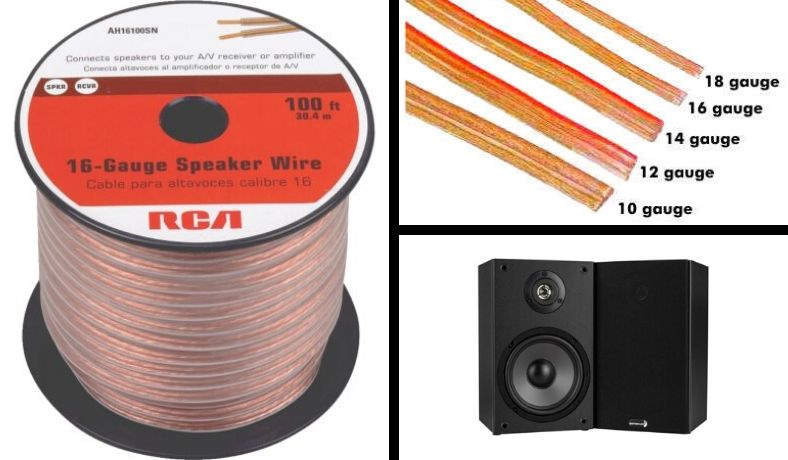
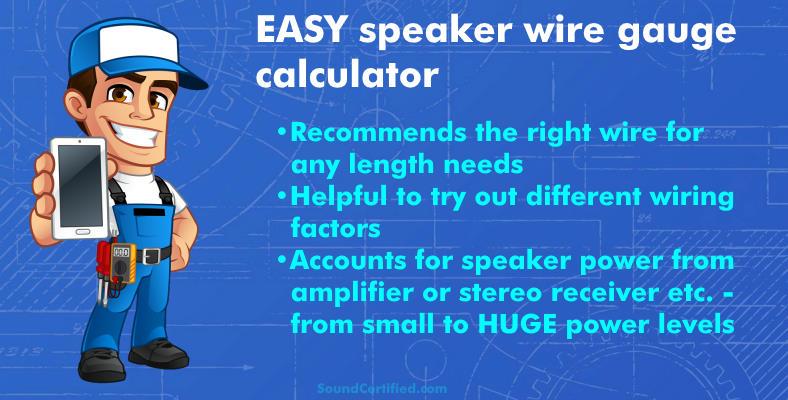
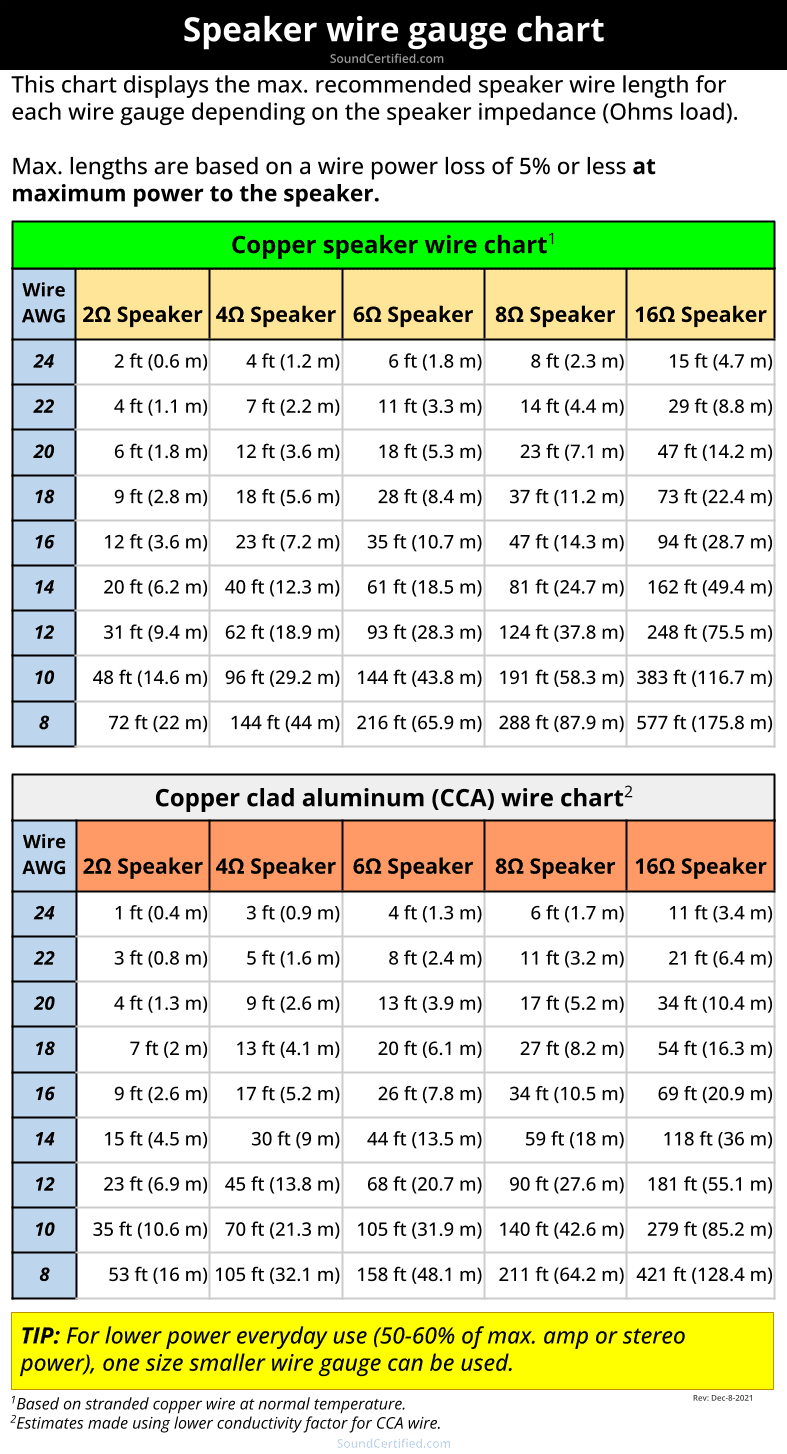
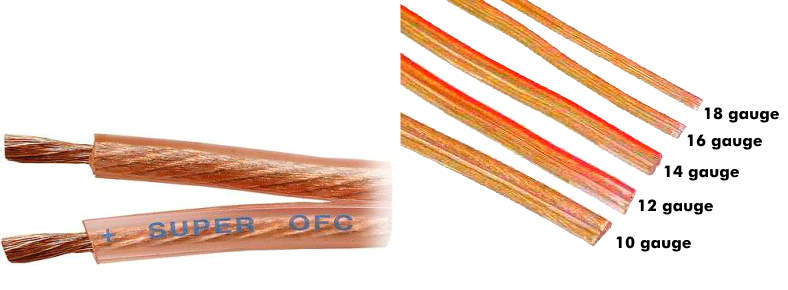
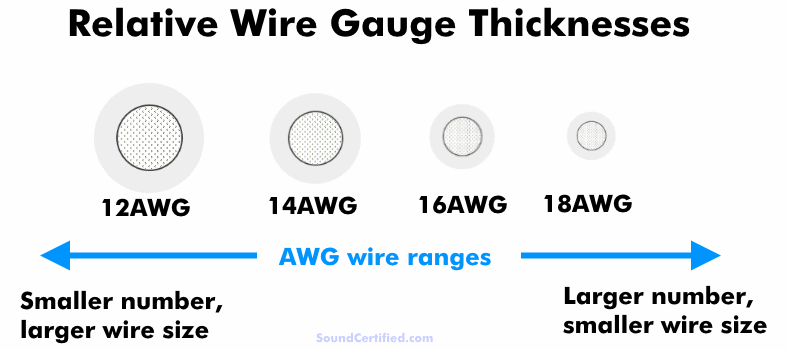

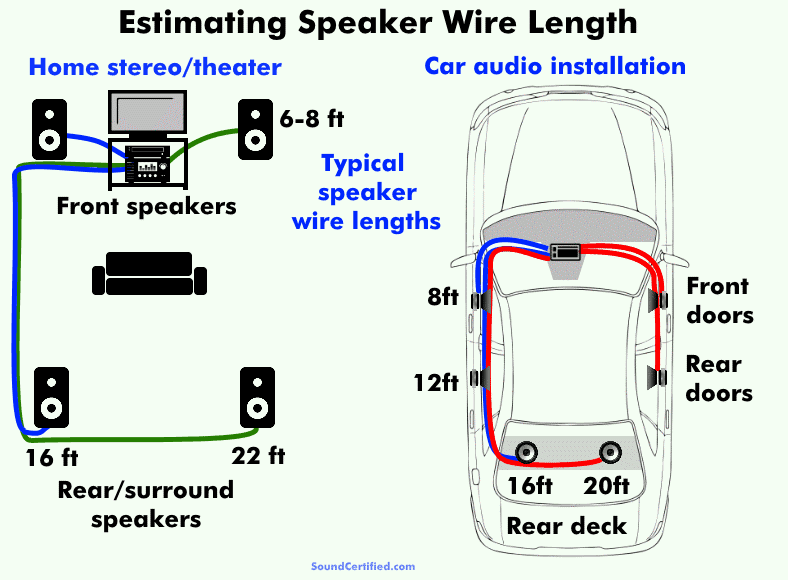
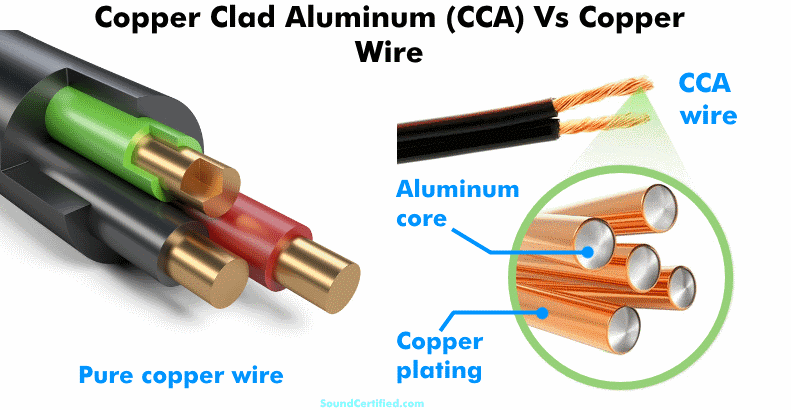
Thanks Marty for the article. A little background to tee up my question: I recently bought an old Peavey Power (bi-amp) mono mixer (XRD 680) that puts out 150w per each of the two channels @ 4 ohms for a soft rock / Americana band I’m in. I am now over my head about all this technical stuff about setting it up for live performances in small venues. I picked up Kustom 2-way speakers – both are 8 ohms but one is equipped with a 12 ” woofer and the other has a 10″ woofer – they are different products. The tweeter for the KCP 12 doesn’t work and is presumed blown but the tweeter for the KCP 10 works fine. Q: Does the blown tweeter of the KCP 12 affect the total impedance of the cabinet (feel free to comment on other aspects of this situation also)? More details here: (KCP 12 rated @ 100 w RMS @ 8 ohms [https://images.thomann.de/pics/atg/atgdata/document/specs/ksc12p_ksc12mp_specifications.pdf ] and KCP 10 [https://images.thomann.de/pics/atg/atgdata/document/spec/ksc10p_ksc10mp_ksc210mp_specifications.pdf] rated at 50 Watts RMS @ 8 ohms]. Thanks!
Hello Bruce. Thanks for supplying the info about the KCP12, as that helps. I see that this speaker design uses a piezo type tweeter.
Piezo tweeters are different from standard tweeters in that they appear to have a *much* higher impedance. Long story short, the total Ohms rating should be about the same regardless of whether the tweeter is in use or not in this case.
I.e., it should still be about 8Ω. Best regards!